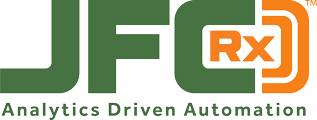This website uses cookies so that we can provide you with the best user experience possible. Cookie information is stored in your browser and performs functions such as recognising you when you return to our website and helping our team to understand which sections of the website you find most interesting and useful.

How Pharmacy Automation Can Drive Revenue Streams and Profit
By Matt Noffsinger, President & Co-Founder, JFCRx
Pharmacy automation is a broad category — it can include vial robots for retail pharmacy settings, adherence packagers for long-term care and hospital facilities that provide patients with multi-dose blister cards or pouch packages, and complex integrations in high volume mail order and central fill settings. No matter the pharmacy setting, the overarching goal of pharmacy automation systems is to streamline pharmacy operations and optimize patient care. Today, however, that goal should expand to include using pharmacy automation solutions to find new sources of revenue.
Pharmacies today are challenged by increased workloads, staffing shortages, pricing pressures, and regulatory compliance requirements, to name a few.
When it comes to new revenue streams, there are three areas of opportunity:
- Labor reallocation
- Using data to identify new prospects
- Working in the continuum of patient care
Using Labor Reallocation to Grow a Revenue Stream
When pharmacy managers decide to invest in a pharmacy automation system, it is usually after the pharmacy automation vendor has presented them with a calculator that shows savings resulting from expected labor reduction and additional marketing capability. The issue with this traditional ROI model is that it requires a reduction in staff in order to actualize the labor savings. If you don’t want to lose good people, the proposed ROI may never be actualized at all.
Specifically, if the pharmacy automation solution is calculated to reduce the expense of half of a technician, the pharmacy should have a plan in place so that within three months of implementing the automation, said pharmacy technician is officially moved into a split role. This not only pressure tests the effectiveness of the automation but also allows reallocating 20 hours a week, enabling the technician to focus on new tasks in a dedicated manner.
New tasks your pharmacy technician could work on include providing Diabetes Self-Management Training (DSMT), a service in which individuals with diabetes receive certified education and training services. A dedicated tech can also collaborate with physician’s offices to discuss new patients and patients facing challenges and offer adherence packaging or Medication Therapy Management (MTM) to eligible patients for which the pharmacy can receive reimbursement under MTM.
Pharmacy technicians can also engage in Comprehensive Medication Reviews (CMRs), playing a significant role in reducing hospital readmissions and the likelihood of adverse events. CMRs not only strengthen the pharmacy’s connection to prescribers but also provide a valuable revenue stream, generating between $35 and $75 per patient per month. Similarly, providing Disease State Management (DSM) services can also yield significant revenue approximately equivalent to CMRs. According to an NIH-published study, the combination of MTM and DSM can generate a revenue stream of approximately $60,000 after labor costs. Most of this work can be efficiently handled by a pharmacy technician with pharmacist supervision. Now, while this might not be game-changing money, it does accomplish a few things:
- Additional revenue
- Tighter prescriber relationships
- Boosts to Star ratings
- Increased likelihood of patient retention
Driving Sales through Data Analysis
Pharmacies have been missing opportunities to drive sales by analyzing the data they already have. This information can be used to better serve patients and improve outcomes. For instance, many pharmacies that have invested in automated packaging technology and used it successfully are leaving a wealth of untapped data within their systems. Consider a case where a distal muscular dystrophy patient is on Carbamazepine, which affects bone density. Although a prescriber may not have addressed this with a prescription, the pharmacy has the information to initiate a conversation with the patient and the provider, proposing the inclusion of Calcium or Vitamin D in a medication adherence program. This not only enhances patient outcomes but also increases sales for the pharmacy. If the patient is already taking a vitamin they buy over-the-counter, there’s an opportunity to market the convenience factor and potential cost savings of purchasing a formulary product from the pharmacy.
This type of cross-reference data analysis could effectively contribute to patient outcomes, increase partnership with providers, and generate revenue for the pharmacy.
Expanding Pharmacy Automation into the Continuum of Care
Pharmacies have long been judged by the number of prescriptions they fill and their refill rates. Everyone knows, especially patients, that pharmacists and their staff are often the front line of care. Pharmacists are often more accessible than a provider, and they are valuable sources of medication and treatment information.
Currently, there are bills in Congress designed to broaden the scope of pharmacists’ role in patient care. This is partly due to the shortage of primary care physicians in the United States. It is exciting to see what groups like the Senior Care Pharmacy Coalition and ASHP are doing in their advocacy for Provider Status in pharmacy to officially recognize and pay pharmacies for these contributions. Even without official provider status in many states, there is certainly an opportunity for pharmacies to fill an essential role in the care of patients beyond their traditional services.
I have seen some interesting models where pharmacies provide remote patient monitoring and data gathering to benefit chronic care management (CCM) and the providers. It makes sense for pharmacies to provide this type of service because they regularly interact with patients and consult on medications and adherence. Medication non-compliance is one of the most prevalent reasons patients experience adverse events or require a hospital or physician visit.
Even as legislation progresses, pharmacies should explore how they can participate in the continuum of care and work on collaborative care agreements. In this way, they can leverage the strength of pharmacy services and open up new revenue streams. It is time for pharmacies to be recognized and compensated for the value they bring to the table.

